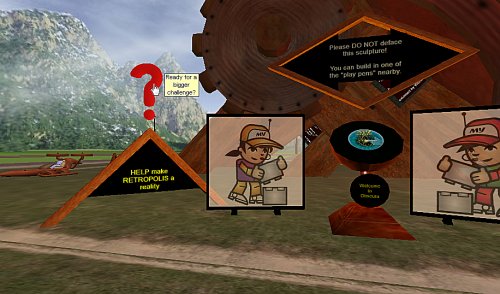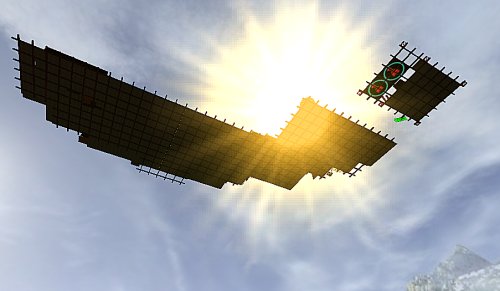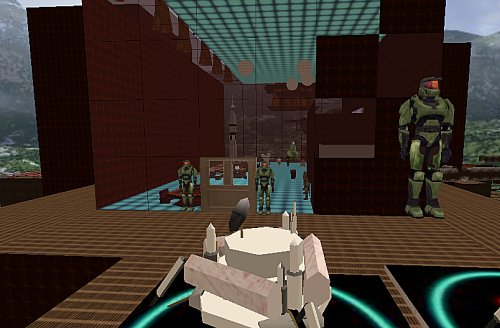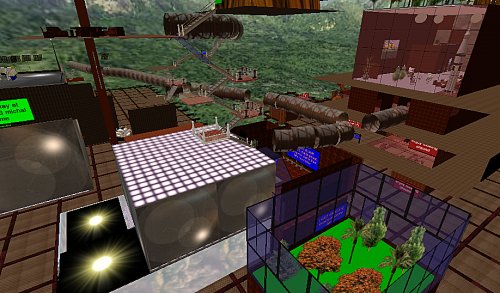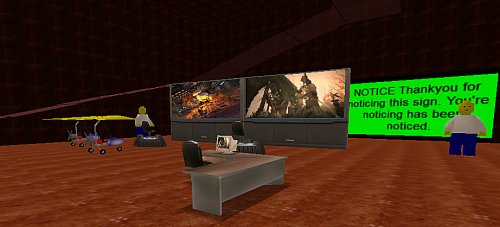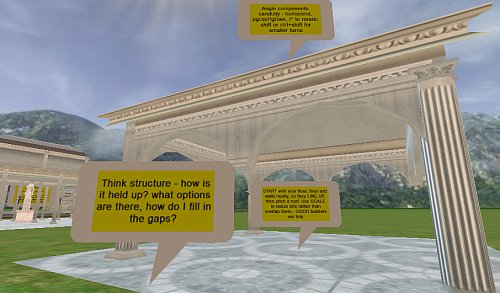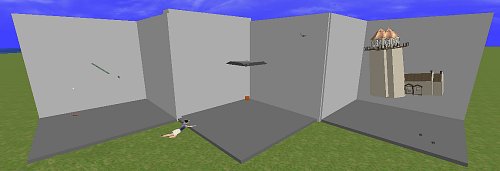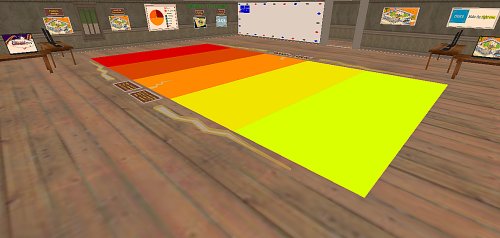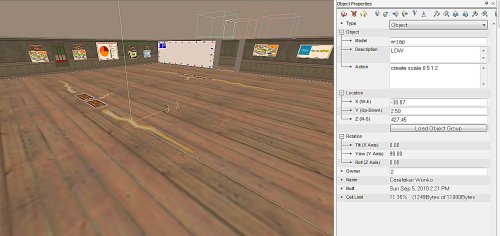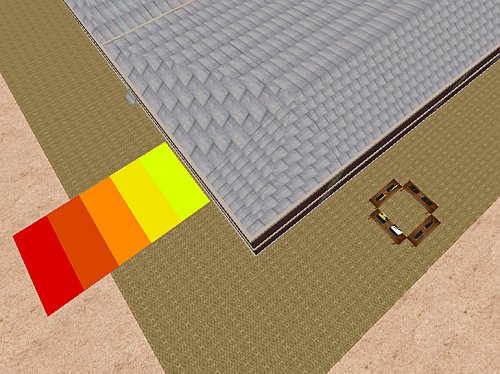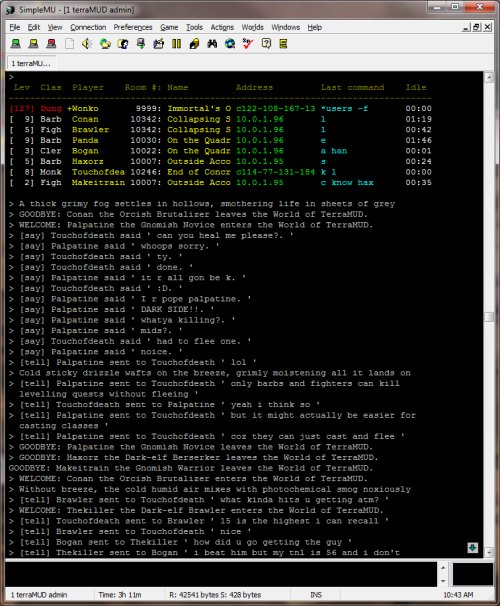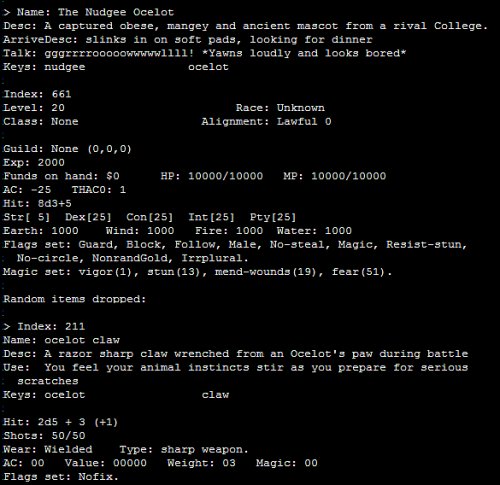SkyCity Revisited…
…I like it when a little organised anarchy works, Sky City is a prime example:
I noticed kids building with lego at altitude, and decided to appropriate the idea, and give them a little structure. I created an “underground” link, phrased in the “mouseover challenge” of wanting to get into something bigger. Rather than splashy and overt, I made the link a little buried, so the kids felt like they had discovered something that not everyone knew about.
Following the link, it warps you up to a platform 400m in the sky, barely visible from the ground (depending on your visibility settings, you get a small blot in the sky until you approach it then this amazing expanse materializes before you)
You land in my “object dock’, a good place to explore materials and check the rules. From this object dock you then look out over a suspended plane (I expand it at night, late, when space is an issue):
…the ONLY guidelines – do not break/obscure anyone elses building – work together. We had to add the rules, it was a little ugly before we did, kids scrapping and getting territorial – you get that.
The results have been, well, honestly, startling.
Some kids have been up here for hours, mostly in their own time (evenings and weekends) sculpting buildings, “homes” and play spaces, often tearing down and starting over when they realise that “tidy” building looks better, that inside spaces need to make sense else getting around them is difficult – don’t architects spend years at uni completely failing to learn this lesson?
Some kids use only the provided materials, MOST source new things, incorporate them, re-cycle and re-purpose, displaying imagination and creativity I as a crusty old adult can only pretend to remember having.
I am honestly impressed with the skill and attention to detail some kids have displayed here. Object alignment, scaling, positioning etc are, for the most part, very sophisticated…
…they worked together, often without any direction or intervention, building things beside and with others – they devised streets, a transport tube system and other modern metropolis entrapments.
For keen (or “difficult”) kids, I changed one or more of thier stationary vehicles into movers that THEY could control – we have hand gliders, thopters and other flying things that kids have build garages for and loan out for joy flights – amazing really. What interested me more was the almost casual (but strategic) suggestions that took TROLLS and turned them into contributing citizens.
Some buildings work really well as buildings – they have internals that are breathtaking, and ramps, stairs, lifts and so on. As adults we look to make sense of our surroundings – kids are not confined by such a narrow view – all pretty amazing stuff, and more importantly a terrific way for them to practice their building skills (which, sssshhh – don’t tell them, is actually why this exists).
Who says chaos and anarchy can not be positive forces…
Tute with a view…
First a little machinema I made earlier: wonkoTOUR
…so I am enriching the noob zone where cybernauts come to learn to build, and am up to the tricky stuff, and have used a few approaches to counter the fact that some of our cybernauts may still be trapped in the concrete operational stages (ie. physically unable to think in 3D yet)
… so am looking at making things visually obvious. Stretching in X, Y and Z are simple enough – but punters need to realize that the axes move as the object moves – sometimes X is up, sometimes pointing to the left and so on. Not sure if I have got it right yet, but have noticed our budding builder buddies are beginning to sensitively size things, so maybe there is just enough theory and plenty of exemplar for them to learn from.
How to describe colour – especially when you have to tell kids to spell it wrong … neways, Activeworlds uses either named colours or html colour codes, so I thought I would demonstrate both, with some colour swatches, link to the help pages on colour models and also to an active html colour mixer, so they can dial up complimentary colours, think that approach is ok, shall see when the punters start using it.
So to describe how to apply a texture, skin, appearance … we have hundreds of stock textures, very few of them have names that make sense to anyone (even the people who originally created them i would hazard to guess), so I showcase what the same shape looks like wrapped in a bunch of different skins, and link to the texture library – not sure there is a better way – having a full texture gallery would be ludicrous I think, but I think eventually we will catalogue them in our object database – browsing will still be hideous I suspect.
I dislike the fact that it is so difficult for the punter to add their own objects and textures in an Activeworld, without being given edit access to the master path .. one of a few bugbears I have about this environment (soz, am used to the creative freedom of Secondlife), still I guess there is a place for cookie-cutter construction with some individual tweaks – is easier for little kids also I suspect and after all, they are our clientelle.
Over at Non-Eco School, we planted an idea, well a tree really that was a place kids could post questions to a scientist – worked a treat, so borrowed that idea for a Builders Q&A tree:
Will be interesting to see what emerges as building issues – I do not do child psychology so have no real idea how successful these things are until I see kids going nuts using the skills.
…all good fun
iProcrastinate 1.01b
…lol
When I should have been busy marking, and other good teachery things, I found the virtual world a great place to just … do … stuff.
Sure, there is plenty to do – the cybernauts are entering the “build” phase of the investigation, so there is a real need for tutorial areas, exemplar builds and the like.
So I began shackling stuff together, to show how it can be done, tried to think through the process I use when building, and how that would translate for a noob.
The Cybernauts have been in, the Roman Villa and associated ruins are taking shape, we now have a market square, bath house, grand house, other assorted buildings – some are really getting into the spirit of the challenge, others are puddling away in “Sky City” – bottom line it does not matter where they practice to build, so long as they do. I even FILMED a walkaround for your viewing pleasure retrowalkaround
I got a little narky – wondered if, with a little careful scaling and rotating it would be possible to make a familiar building … 20 minutes later:
…a 1/4 scale version of the main concert hall roof structure (I love this place in the real world) – buggered if this does not solve a problem I was wrestling with over on Sci Prime – the roofline of my Observatory will be these familiar sails I think. We shall see.
The Object Catalog is gradually coming together, with a team of patient people popping and screen-grabbing objects for it over on SomaIII, will be seriously hoopy when done:
4 people working at a time, huge job (thousands of objects to index), progress being made, all good.
Half full, or half empty…
Activeworlds have a peculiarity (well, I think it is peculiar, and I think fairly unique for 3D worlds – correct me if I am wrong) in that each “cell” has a storage limit (measured in bytes). The upshot of this is that there is a LIMIT to how much data can reside at each point in the world, with objects and their definition and modifications taking up the space.
When you reach the cell limit (a 10x10m chunk that extends both UP into the sky and DOWN underground) the world actively prevents anyone from building anything more there. 11000 bytes seems a lot, but it is not if the object names are long, and the object contains much scripting, web references and so on. This is peculiar and potentially a huge problem in a world that we want kids (who may not be experts, geeks or, indeed should they need to care about such issues) making complex things.
I noticed this when puddling around in a multi-level building in a busy corner and wondered how I might “save some bytes” – you can do it “dirtily” by trimming off the “.rwx” of the object name, and shortening the action strings (small urls, minimal descriptions) and use large objects instead of lots of little ones … but sometimes, you know, you want it rich, varied and well described.
In reading user forums, it seems I am not the first to think this odd and inconvenient, but found a rather ingenious solution, let me explain…
So, this room is full of stuff for kids to explore and play with:
… a floor graph, some post boards, some interactives and so on and it all looks like it is ready to use – which, from the user’s perspective, it is.
What is interesting (well, I find it interesting) is that much of what you see here, is not …actually … there – it is defined elsewhere and slushes into its nominated positions via a MOVE command the instant it pops into existence:
Once you get the hang of this, you can cache huge chunks of stuff in previously unused space and have it moved automatically into use instantly:
I used a script similar to the following:
on create move 18 0 0 time=0 wait=9e9
…which means, when the object rezzes in-world, move it 18m in the X axis, 0 in Y and Z, then wait 9000000000 seconds before moving it back (yes, 9e9 is a fiarly odd number – for world purposes that is “forever”). Using this technique, so long as you know where the thing is to end up, you can move it there by script.
The _only_ caveat here is, as I discovered, if you want kids to work with the object by creating more around it – then you cannot use this technique because the moment you switch to edit move, the objects seemingly disappear back to their point of origin.
Still, learning something new is a good thing, right?
Let the chase begin …
…so in my text-based world (tmux), players like a group challenge – oddly (or more correctly characteristically) they like to band together to defeat a common enemy.
Now, borrowing heavily from Monty Python and “Ripping Yarns” by Palin and Jones, I had created an arch memesis – “The College Leopard” – a cute idea that there was an aging, mangey, near-toothless college mascot that would roam the corridors menacingly – the first leopard hunt was great fun – stuff of legends.
When the leopard retired – toothless and all shagged out, a new nemesis was born – a mascott from a rival college “The Nudgee Ocelot” arrived on the scene and has visited in-world a few times, causing great excitement and smiting many noobs. I am yet to understand inter-school rivalry, but am the first to hijack it when it is convenient 😛
For those keeping up, an Ocelot is a curiosity in itself – names a “big cat”, it is in fact the smallest of the big-cat family, and usually actually smaller than a domestic moggy – which I find amusing. I have touted the idea of the IGS Iguana, Grammar Aardvark and the TSS Thylacine – all of whom may make a cameo appearance soon also.
Friday evening (yes, after a long week at school, kids choose to play a school-hosted, school-themed MMORPG – weird but wonderful, hey) the community called for another hunt, the Ocelot was suggested as a foe so it was on.
Now I like to mix things up a little, but being a responsible DM (Dungeon Master, yeah, I know, doesn’t sound right to me either) I tweaked the ocelot so it was killable, eventually, but not without a fight. I gave it a bunch of magic points, allowed it to cast restorative spells on itself and some offensive spells on whoever chose to attack it, but had to be careful that it would not be too ferocious. I manufactured a weapon (an ocelot claw) that I then gave to the ocelot – I figured 20 of them would be useful and, depending on whether many punters showed up, there would be enough to go around.
Role-playing as the ocelot is exahusting, but sort of fun – the balance between damage and sport, defeat and victory is delicate, but as the battle raged in and around St. Joe’s eCampus (did I mention this MMORPG is actually set in a future version of our school?) and as the ocelot took major hits, it discarded claws to it’s attackers.
In this round the Ocelot was defeated, but vowed to return some day (yes, it …talked, sort of, and goaded the eager terrace students on during the battle). Unfortunately, just after it was all done and dusted, my wireless dropped out and I lost my log, else I would have posted it – players were wanting to know who did what damage, who hit, when, what spells did what damage and so on.
We had a pack of kids on, some veterans, some noobs – interesting mix of classes, abilities and approaches.
The hunt involved HUGE amounts of reading, typing, and imagination, but was also a load of fun – wonderful that kids choose to immerse in this sort of world, conjuring up pictures of their surroundings using their imagination – it is refreshing to think that some of the youth of today still have imaginations that do not revolve around visual imagery.
…just thought I would share – this is ONE of the worlds I inhabit daily after all.
